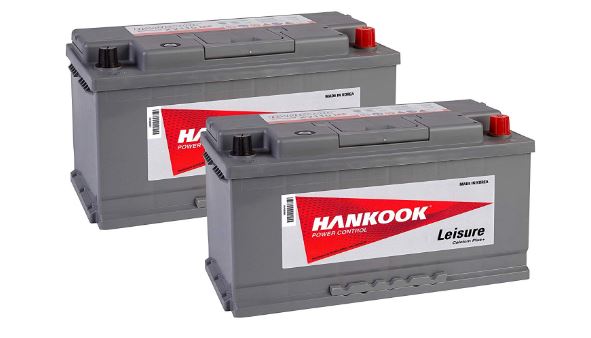
Leisure batteries and their performance is a topic I’ve discussed with our guests many times over the years. I’ve written a comprehensive post previously on the different types of leisure batteries, their pros and cons etc. So if you are looking to purchase a new leisure battery for your motorhome I would encourage you to read that post by clicking here. With this post, however, I want to cover something which is also important, the placement of the leisure battery in a motorhome. Now, this topic is not only important for those who have decided to take on the challenge of building their own motorhome.

Leisure batteries and their associated electronics can account for a considerable amount of weight. Some motorhomes will even have a double battery setup. Therefore their placement is an important consideration: Image – Amazon.co.uk
Disclaimer: Hey! By the way… any links on this page that lead to products on Amazon or Caravan Guard are affiliate links, and I earn a commission if you make a purchase, with no additional cost to you 🙂
- Dissolves waste and removes odours naturally and has delightful mild fragrance
If you are purchasing a new or second-hand motorhome I would encourage you to consider the placement of the leisure battery as it may have more significant implications than you initially think.
The performance and placement of leisure batteries in motorhomes are important for several reasons. First, if you want to go wild/off-grid camping, you need that leisure battery to reliably meet your needs.
In today’s modern world, we are using electric devices more and more.
So as well as requiring the leisure battery to run your 12V system, you also will require it to charge your devices (phones, tablets, laptops etc).
Furthermore, security systems such as alarms and trackers require power. While many have their own internal battery, the fallback position is to pull power from the leisure battery.
Want To Visit Horton Common? – Book Here
Table of Contents
Introduction To Motorhome Leisure Batteries & Their Placement
I’ve had a couple of guests over the years who have built their own motorhome or refurbished one.
I like DIY, so I often get into conversations with them about the process they went through and the challenges they had to overcome.
Something which has come up several times is choosing a suitable place for the leisure battery. The reason being some of the older vans didn’t have a location for the leisure battery.
Or the previously allocated space was too small to fit a modern large leisure battery.
However, if you are looking to purchase a new or second-hand motorhome, leisure battery placement is also something you should consider.
To emphasize that point, I would encourage you to watch the video below from Practical Motorhome on leisure battery placement:
Distance From The Motorhomes Alternator
So the first topic John discusses in the video above is the distance from the alternator on your motorhome.
As stated, you don’t want the leisure battery to be mounted too far away from the alternator due to a potential drop in charging power.
The reason being with DC (Direct Current), you lose power over longer distances unless you have thicker cables. However, thicker copper cables are expensive.
Therefore as John states in the video, the worse placement of the leisure battery on a motorhome is right at the back.
Not only will this likely result in poor charging performance, but also poor weight distribution.
Motorhome Leisure Battery Weight
So when it comes to leisure batteries on motorhomes and their placement with regard to weight, there are two factors to consider.
The impact of the weight of the leisure batteries and the reduction in user payload. The second consideration is weight distribution. First, let’s discuss the weight of leisure batteries:

A fairly average-sized motorhome will have a user payload of around 300kg. Well, a single 100Ah leisure battery will weigh around 20kg.
Therefore if you have a double battery setup, that’s 40kg. You also have to factor in, say, around 5kg for the associated charge controller etc.
Therefore with a double battery setup, you could be looking at around 45kg in weight just for the leisure batteries. That’s quite a lot of your 300kg user payload. In fact, its 15%!
Motorhome Leisure Battery Weight Distribution
So I think we can agree leisure batteries are heavy. Well, if those heavy leisure batteries are placed right at the back of your motorhome chassis (the overhang), that could potentially affect the handling.
Putting more weight in the overhang behind the rear axle reduces the load on the front axle.
The front axle in most UK motorhomes handles both the propulsion and steering. Hence, reducing the load on the front axle can mean reduced traction and steering feel.
If you start to load bikes on the back of the motorhome, which is common, this will compound the effect.
So, in summary, avoid purchasing a motorhome with leisure batteries behind the rear axle in the overhang.
External Or Internal Motorhome Leisure Battery Placement
When you’re looking at your next motorhome purchase, its worth investigating whether the leisure battery is stored externally in a locker, for instance, or internally within the motorhome.
As John shows in the video, temperature plays a significant role in the capacity and performance of your leisure battery.
The leisure battery’s rated capacity is based on an ambient temperature of 25 degrees Celcius, which is essentially a typical warm summer’s day here in the UK.

This fairly typical 110AH leisure battery outside of the summer season does not actually have a 110AH capacity: Image – Amazon.co.uk
Temperature Impacts Leisure Battery Performance
For every 1% temperature drop, you will lose 1% of the leisure batteries rated output.
Hence, as shown in the video, a 110AH motorhome leisure battery will only have a capacity of 88AH in winter conditions at around 5 degrees Celcius.
So the point is you don’t want your leisure battery to get cold. Not only does it reduce the capacity in freezing conditions, but the battery may actually be permanently damaged.
If your motorhome leisure battery is stored in an external locker, you could consider some form of insulation.
However, that will only slow the rate of temperature change in the locker. As there is no source of heat, the temperature will still drop, just at a slower rate.

You could insulate the leisure battery locker with a suitable foil insulation material. However, over sustained periods of low temperatures, the leisure battery will still be exposed to potentially freezing conditions: Image – Amazon.co.uk
If you don’t use your motorhome over the winter months and its not required to run an alarm or tracker, I would encourage you to keep the leisure battery indoors.
However, while charging as John notes in the video you have to be aware of battery ‘off-gassing’. So only charge a leisure battery where there is good ventilation.
Leisure Battery Charging
If the motorhome is in storage over the winter months or sitting idle on your drive, its important to use a leisure battery charger.
This will maintain the health of the leisure battery. However, some chargers have more features than others.
Some can even recover certain leisure batteries from a significantly depleted state of charge or those that have been exposed to freezing conditions.
If you notice in the video above, in John’s leisure battery installation, he used a CTEK charger.
Generally, from discussions I’ve had with our guests in the past, they are currently regarded as the best chargers available:

This is CTEKs most powerful portable leisure battery charger with an output of 10 amps. But they also have more affordable units with outputs down to as low as 3.8 amps: Image – Amazon.co.uk
There is another method you can use to keep your motorhome leisure battery topped up and in good condition, and that’s with a solar panel.
Quite a few of our guests have had solar panels mounted to the roof of their motorhomes.
However, if the permanently mounted route puts you off either because it sounds too expensive or you don’t want a new hole in your motorhome roof, you could consider a portable solar panel.

There are many different sized portable solar panel kits online. Typically they have a 100W output such as this example: Image – Amazon.co.uk
You will need a charge controller which will manage the output of the solar panel to what your leisure battery requires. Many solar panel kits come with a charge controller, but not all of them.
Portable solar panels can be a practical way of getting your leisure battery through the winter months still in good condition.
Conclusions On Motorhome Leisure Battery Placement
Typically when looking to buy a new or second-hand motorhome or even building your own, you will be thinking about leisure battery size. How many amp-hours do I need to run my appliances/devices?
Do I want a double battery setup for wild/off-grid camping?
Is the leisure battery larger enough to power an inverter? There are many considerations when it comes to the size and power of the battery.
However, as shown above, I would also encourage you to consider the placement and location of that leisure battery.
Its often a forgotten consideration, but it can have a big impact on user payload, battery performance and even vehicle handling and traction.
I hope you found this post useful and gave you something to think about when it comes to the placement of the leisure battery in your motorhome.
I also hope, at some point in the future, you consider coming to visit us here at Horton Common to experience our fully serviced pitches. 🙂
Want To Visit Horton Common? – Book Here


